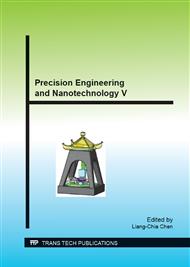p.85
p.91
p.101
p.108
p.115
p.123
p.129
p.134
p.140
A Study of the Cutting Temperatures in Milling Stainless Steels Using Chamfered Main Cutting Edge Nose Radius Worn Tools
Abstract:
The main purpose of this paper is to study the carbide tip's surface temperature and the cutting forces of milling stainless steel with nose radius worn tools. A new cutting temperatures model incorporating tool worn factor and using the variations of shear and friction plane areas occurring in tool worn situations are presented in this paper. The frictional forces and heat generation on elementary cutting tools are calculated by using the measured cutting forces and the oblique cutting analysis. The tool tip and cutting edges are treated as a series of elementary cutting tips. The carbide tip’s temperature distribution is solved by finite element analysis (FEM) method. Keywords: Milling, stainless steel, cutting temperatures, nose radius tools, FEM
Info:
Periodical:
Pages:
115-122
Citation:
Online since:
August 2014
Authors:
Price:
Сopyright:
© 2015 Trans Tech Publications Ltd. All Rights Reserved
Share:
Citation:


